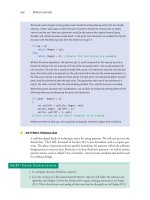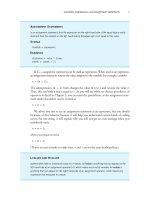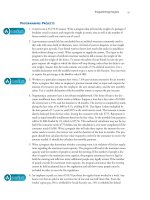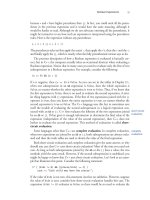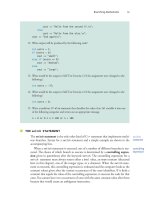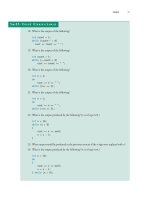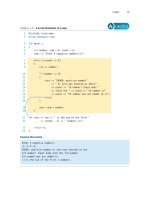Absolute C++ (4th Edition) part 19 pptx
Bạn đang xem bản rút gọn của tài liệu. Xem và tải ngay bản đầy đủ của tài liệu tại đây (220.52 KB, 10 trang )
182 Arrays
Self-Test Exercises
If the value of i is 3, then the argument is a[3]. On the other hand, if the value of i is
0, then this call is equivalent to the following:
myFunction(a[0]);
The indexed expression is evaluated in order to determine exactly which indexed vari-
able is given as the argument.
11. Consider the following function definition:
void tripler(int& n)
{
n = 3*n;
}
Which of the following are acceptable function calls?
int a[3] = {4, 5, 6}, number = 2;
tripler(a[2]);
tripler(a[3]);
tripler(a[number]);
tripler(a);
tripler(number);
12. What (if anything) is wrong with the following code? The definition of tripler is given in
Self-Test Exercise 11.
int b[5] = {1, 2, 3, 4, 5};
for (int i = 1; i <= 5; i++)
tripler(b[i]);
■
ENTIRE ARRAYS AS FUNCTION ARGUMENTS
A function can have a formal parameter for an entire array so that when the function is
called, the argument that is plugged in for this formal parameter is an entire array.
However, a formal parameter for an entire array is neither a call-by-value parameter nor
a call-by-reference parameter; it is a new kind of formal parameter referred to as an
array parameter. Let’s start with an example.
The function defined in Display 5.3 has one array parameter,
a, which will be
replaced by an entire array when the function is called. It also has one ordinary call-by-
value parameter (
size) that is assumed to be an integer value equal to the size of the
array. This function fills its array argument (that is, fills all the array’s indexed variables)
array
parameter
05_CH05.fm Page 182 Wednesday, August 13, 2003 12:51 PM
Arrays in Functions 183
with values typed in from the keyboard; the function then outputs a message to the
screen telling the index of the last array index used.
The formal parameter
int a[] is an array parameter. The square brackets, with no
index expression inside, are what C++ uses to indicate an array parameter. An array
parameter is not quite a call-by-reference parameter, but for most practical purposes it
behaves very much like a call-by-reference parameter. Let’s go through this example in
detail to see how an array argument works in this case. (An array argument is, of
course, an array that is plugged in for an array parameter, such as
a[].)
When the function
fillUp is called, it must have two arguments: The first gives an
array of integers, and the second should give the declared size of the array. For example,
the following is an acceptable function call:
int score[5], numberOfScores = 5;
fillUp(score, numberOfScores);
This call to fillUp will fill the array score with five integers typed in at the keyboard.
Notice that the formal parameter
a[] (which is used in the function declaration and
the heading of the function definition) is given with square brackets but no index
expression. (You may insert a number inside the square brackets for an array parameter,
but the compiler will simply ignore the number, so we will not use such numbers in
this book.) On the other hand, the argument given in the function call (
score, in this
example) is given without any square brackets or any index expression.
Display 5.3 Function with an Array Parameter
F
UNCTION
D
ECLARATION
void fillUp(int a[], int size);
//Precondition: size is the declared size of the array a.
//The user will type in size integers.
//Postcondition: The array a is filled with size integers
//from the keyboard.
F
UNCTION
D
EFINITION
void fillUp(int a[], int size)
{
cout << "Enter " << size << " numbers:\n";
for (int i = 0; i < size; i++)
cin >> a[i];
cout << "The last array index used is " << (size - 1) << endl;
}
array
argument
when to
use
[]
05_CH05.fm Page 183 Wednesday, August 13, 2003 12:51 PM
184 Arrays
What happens to the array argument score in this function call? Very loosely speak-
ing, the argument
score is plugged in for the formal array parameter a in the body of
the function, and then the function body is executed. Thus, the function call
fillUp(score, numberOfScores);
is equivalent to the following code:
{
size = 5;
cout << "Enter " << size << " numbers:\n";
for (int i = 0; i < size; i++)
cin >> score[i];
cout << "The last array index used is " << (size - 1) << endl;
}
The formal parameter a is a different kind of parameter from the ones we have seen
before now. The formal parameter
a is merely a placeholder for the argument score.
When the function
fillUp is called with score as the array argument, the computer
behaves as if
a were replaced with the corresponding argument score. When an array is
used as an argument in a function call, any action that is performed on the array
parameter is performed on the array argument, so the values of the indexed variables of
the array argument can be changed by the function. If the formal parameter in the
function body is changed (for example, with a
cin statement), then the array argument
will be changed.
So far it looks as if an array parameter is simply a call-by-reference parameter for an
array. That is close to being true, but an array parameter is slightly different from a call-by-
reference parameter. To help explain the difference, let’s review some details about arrays.
Recall that an array is stored as a contiguous chunk of memory. For example, con-
sider the following declaration for the array
score:
int score[5];
When you declare this array, the computer reserves enough memory to hold five vari-
ables of type
int, which are stored one after the other in the computer’s memory. The
computer does not remember the addresses of each of these five indexed variables; it
remembers only the address of indexed variable
score[0]. The computer also remem-
bers that
score has a total of five indexed variables, all of type int. It does not remem-
ber the address in memory of any indexed variable other than
score[0]. For example,
when your program needs
score[3], the computer calculates the address of score[3]
from the address of score[0]. The computer knows that score[3] is located three int
variables past score[0]. Thus, to obtain the address of score[3], the computer takes
the address of
score[0] and adds a number that represents the amount of memory
used by three
int variables; the result is the address of score[3].
Viewed this way, an array has three parts: the address (location in memory) of the
first indexed variable, the base type of the array (which determines how much memory
5 is the value of
numberOfScores
arrays in
memory
05_CH05.fm Page 184 Wednesday, August 13, 2003 12:51 PM
Arrays in Functions 185
each indexed variable uses), and the size of the array (that is, the number of indexed
variables). When an array is used as an array argument to a function, only the first of
these three parts is given to the function. When an array argument is plugged in for its
corresponding formal parameter, all that is plugged in is the address of the array’s first
indexed variable. The base type of the array argument must match the base type of the
formal parameter, so the function also knows the base type of the array. However, the
array argument does not tell the function the size of the array. When the code in the func-
tion body is executed, the computer knows where the array starts in memory and how
much memory each indexed variable uses, but (unless you make special provisions) it
does not know how many indexed variables the array has. That is why it is critical that
you always have another
int argument telling the function the size of the array. (That
is also why an array parameter is not the same as a call-by-reference parameter. You can
think of an array parameter as a weak form of call-by-reference parameter in which
everything about the array is told to the function except for the size of the array.)
2
These array parameters may seem a little strange, but they have at least one very nice
property as a direct result of their seemingly strange definition. This advantage is best
illustrated by again looking at our example of the function
fillUp given in Display 5.3.
That same function can be used to fill an array of any size, as long as the base type of the
array is
int. For example, suppose you have the following array declarations:
int score[5], time[10];
The first of the following calls to fillUp fills the array score with five values, and the
second fills the array
time with ten values:
fillUp(score, 5);
fillUp(time, 10);
You can use the same function for array arguments of different sizes, because the size is
a separate argument.
■
THE
const
PARAMETER MODIFIER
When you use an array argument in a function call, the function can change the values
stored in the array. This is usually fine. However, in a complicated function definition,
you might write code that inadvertently changes one or more of the values stored in an
array even though the array should not be changed at all. As a precaution, you can tell
the compiler that you do not intend to change the array argument, and the computer
will then check to make sure your code does not inadvertently change any of the values
in the array. To tell the compiler that an array argument should not be changed by your
function, insert the modifier
const before the array parameter for that argument
2
If you have heard of pointers, this will sound like pointers and indeed an array augment is
passed by passing a pointer to its first (zeroth) index variable. We will discuss this in Chapter 10.
If you have not yet learned about pointers, you can safely ignore this footnote.
Different
size array
arguments
can be
plugged in
for the
same array
parameter
const
05_CH05.fm Page 185 Wednesday, August 13, 2003 12:51 PM
186 Arrays
position. An array parameter that is modified with a const is called a constant array
parameter.
For example, the following function outputs the values in an array but does not
change the values in the array:
void showTheWorld(int a[], int sizeOfa)
//Precondition: sizeOfa is the declared size of the array a.
//All indexed variables of a have been given values.
//Postcondition: The values in a have been written to the screen.
{
cout << "The array contains the following values:\n";
for (int i = 0; i < sizeOfa; i++)
cout << a[i] << " ";
cout << endl;
}
This function will work fine. However, as an added safety measure, you can add the
modifier
const to the function heading as follows:
void showTheWorld(const int a[], int sizeOfa)
A
RRAY
F
ORMAL
P
ARAMETERS
AND
A
RGUMENTS
An argument to a function may be an entire array, but an argument for an entire array is neither
a call-by-value argument nor a call-by-reference argument. It is a new kind of argument known
as an
array argument
. When an array argument is plugged in for an
array parameter
, all that is
given to the function is the address in memory of the first indexed variable of the array argument
(the one indexed by 0). The array argument does not tell the function the size of the array. There-
fore, when you have an array parameter to a function, you normally must also have another for-
mal parameter of type
int that gives the size of the array (as in the example below).
An array argument is like a call-by-reference argument in the following way: If the function body
changes the array parameter, then when the function is called, that change is actually made to
the array argument. Thus, a function can change the values of an array argument (that is, can
change the values of its indexed variables).
The syntax for a function declaration with an array parameter is as follows.
S
YNTAX
Type_Returned
Function_Name
( ,
Base_Type
Array_Name
[], );
E
XAMPLE
void sumArray(double& sum, double a[], int size);
constant array
parameter
05_CH05.fm Page 186 Wednesday, August 13, 2003 12:51 PM
Arrays in Functions 187
Pitfall
With the addition of this modifier const, the computer will issue an error message if
your function definition contains a mistake that changes any of the values in the array
argument. For example, the following is a version of the function
showTheWorld that
contains a mistake that inadvertently changes the value of the array argument. Fortu-
nately, this version of the function definition includes the modifier
const, so that an
error message will tell us that the array
a has been changed. This error message will help
to explain the mistake:
void showTheWorld(const int a[], int sizeOfa)
//Precondition: sizeOfa is the declared size of the array a.
//All indexed variables of a have been given values.
//Postcondition: The values in a have been written to the screen.
{
cout << "The array contains the following values:\n";
for (int i = 0; i < sizeOfa; a[i]++)
cout << a[i] << " ";
cout << endl;
}
If we had not used the const modifier in the above function definition and if we made
the mistake shown, the function would compile and run with no error messages. How-
ever, the code would contain an infinite loop that continually increments
a[0] and
writes its new value to the screen.
The problem with this incorrect version of
showTheWorld is that the wrong item is
incremented in the
for loop. The indexed variable a[i] is incremented, but it should
be the index
i that is incremented. In this incorrect version, the index i starts with the
value
0 and that value is never changed. But a[i], which is the same as a[0], is incre-
mented. When the indexed variable
a[i] is incremented, that changes a value in the
array, and since we included the modifier
const, the computer will issue a warning
message. That error message should serve as a clue to what is wrong.
You normally have a function declaration in your program in addition to the func-
tion definition. When you use the
const modifier in a function definition, you must
also use it in the function declaration so that the function heading and the function
declaration are consistent.
The modifier
const can be used with any kind of parameter, but it is normally used
only with array parameters and call-by-reference parameters for classes, which are dis-
cussed in Chapters 6 and 7.
I
NCONSISTENT
U
SE
OF
const
P
ARAMETERS
The const parameter modifier is an all-or-nothing proposition. If you use it for one array param-
eter of a particular type, then you should use it for every other array parameter that has that type
and that is not changed by the function. The reason has to do with function calls within function
Mistake, but the compiler
will not catch it unless you
use the
const modifier.
05_CH05.fm Page 187 Wednesday, August 13, 2003 12:51 PM
188 Arrays
Example
calls. Consider the definition of the function showDifference, which is given below along with
the declaration of a function used in the definition:
double computeAverage(int a[], int numberUsed);
//Returns the average of the elements in the first numberUsed
//elements of the array a. The array a is unchanged.
void showDifference(const int a[], int numberUsed)
{
double average = computeAverage(a, numberUsed);
cout << "Average of the " << numberUsed
<< " numbers = " << average << endl
<< "The numbers are:\n";
for (int index = 0; index < numberUsed; index++)
cout << a[index] << " differs from average by "
<< (a[index] - average) << endl;
}
The above code will give an error message or warning message with most compilers. The function
computeAverage does not change its parameter a. However, when the compiler processes the
function definition for
showDifference, it will think that computeAverage does (or at least
might) change the value of its parameter
a. This is because when it is translating the function defi-
nition for
showDifference, all the compiler knows about the function computeAverage is the
function declaration for
computeAverage, which does not contain a const to tell the compiler
that the parameter
a will not be changed. Thus, if you use const with the parameter a in the func-
tion
showDifference, then you should also use the modifier const with the parameter a in the
function
computeAverage. The function declaration for computeAverage should be as follows:
double computeAverage(const int a[], int numberUsed);
■
FUNCTIONS THAT RETURN AN ARRAY
A function may not return an array in the same way that it returns a value of type int
or double. There is a way to obtain something more or less equivalent to a function
that returns an array. The thing to do is return a pointer to the array. We will discuss
this topic when we discuss the interaction of arrays and pointers in Chapter 10. Until
you learn about pointers, you have no way to write a function that returns an array.
P
RODUCTION
G
RAPH
Display 5.4 contains a program that uses an array and a number of array parameters. This pro-
gram for the Apex Plastic Spoon Manufacturing Company displays a bar graph showing the pro-
ductivity of each of its four manufacturing plants for any given week. Plants keep separate
05_CH05.fm Page 188 Wednesday, August 13, 2003 12:51 PM
Arrays in Functions 189
production figures for each department, such as the teaspoon department, soup spoon depart-
ment, plain cocktail spoon department, colored cocktail spoon department, and so forth. More-
over, each of the four plants has a different number of departments.
As you can see from the sample dialogue in Display 5.4, the graph uses one asterisk for each 1000
production units. Since output is in units of 1000, it must be scaled by dividing it by 1000. This
presents a problem because the computer must display a whole number of asterisks. It cannot
display 1.6 asterisks for 1600 units. We therefore round to the nearest thousand. Thus, 1600 will be
the same as 2000 and will produce two asterisks.
The array
production holds the total production for each of the four plants. In C++, array
indexes always start with
0. But since the plants are numbered 1 through 4, rather than 0 through
3, we have placed the total production for plant number n in indexed variable production
[n-1]
. The total output for plant number 1 will be held in production[0], the figures for plant
2 will be held in
production[1], and so forth.
Since the output is in thousands of units, the program will scale the values of the array elements.
If the total output for plant number 3 is 4040 units, then the value of production[2] will ini-
tially be set to
4040. This value of 4040 will then be scaled to 4 so that the value of produc-
tion[2]
is changed to 4 and four asterisks will be output to represent the output for plant
number 3. This scaling is done by the function
scale, which takes the entire array production
as an argument and changes the values stored in the array.
The function round rounds its argument to the nearest integer. For example, round(2.3)
returns
2, and round(2.6) returns 3. The function round was discussed in Chapter 3, in the
programming example entitled “A Rounding Function”.
round
Display 5.4 Production Graph Program
(part 1 of 4)
1 //Reads data and displays a bar graph showing productivity for each plant.
2 #include <iostream>
3 #include <cmath>
4 using namespace std;
5 const int NUMBER_OF_PLANTS = 4;
6 void inputData(int a[], int lastPlantNumber);
7 //Precondition: lastPlantNumber is the declared size of the array a.
8 //Postcondition: For plantNumber = 1 through lastPlantNumber:
9 //a[plantNumber-1] equals the total production for plant number plantNumber.
10 void scale(int a[], int size);
11 //Precondition: a[0] through a[size-1] each has a nonnegative value.
12 //Postcondition: a[i] has been changed to the number of 1000s (rounded to
13 //an integer) that were originally in a[i], for all i such that 0 <= i <= size-1.
05_CH05.fm Page 189 Wednesday, August 13, 2003 12:51 PM
190 Arrays
Display 5.4 Production Graph Program
(part 2 of 4)
14 void graph(const int asteriskCount[], int lastPlantNumber);
15 //Precondition: a[0] through a[lastPlantNumber-1] have nonnegative values.
16 //Postcondition: A bar graph has been displayed saying that plant
17 //number N has produced a[N-1] 1000s of units, for each N such that
18 //1 <= N <= lastPlantNumber
19 void getTotal(int& sum);
20 //Reads nonnegative integers from the keyboard and
21 //places their total in sum.
22 int round(double number);
23 //Precondition: number >= 0.
24 //Returns number rounded to the nearest integer.
25 void printAsterisks(int n);
26 //Prints n asterisks to the screen.
27 int main( )
28 {
29 int production[NUMBER_OF_PLANTS];
30 cout << "This program displays a graph showing\n"
31 << "production for each plant in the company.\n";
32 inputData(production, NUMBER_OF_PLANTS);
33 scale(production, NUMBER_OF_PLANTS);
34 graph(production, NUMBER_OF_PLANTS);
35 return 0;
36 }
37 void inputData(int a[], int lastPlantNumber)
38 {
39 for (int plantNumber = 1;
40 plantNumber <= lastPlantNumber; plantNumber++)
41 {
42 cout << endl
43 << "Enter production data for plant number "
44 << plantNumber << endl;
45 getTotal(a[plantNumber - 1]);
46 }
47 }
48 void getTotal(int& sum)
49 {
05_CH05.fm Page 190 Wednesday, August 13, 2003 12:51 PM
Arrays in Functions 191
Display 5.4 Production Graph Program
(part 3 of 4)
50 cout << "Enter number of units produced by each department.\n"
51 << "Append a negative number to the end of the list.\n";
52 sum = 0;
53 int next;
54 cin >> next;
55 while (next >= 0)
56 {
57 sum = sum + next;
58 cin >> next;
59 }
60 cout << "Total = " << sum << endl;
61 }
62
63 void scale(int a[], int size)
64 {
65 for (int index = 0; index < size; index++)
66 a[index] = round(a[index]/1000.0);
67 }
68 int round(double number)
69 {
70 return static_cast<int>(floor(number + 0.5));
71 }
72 void graph(const int asteriskCount[], int lastPlantNumber)
73 {
74 cout << "\nUnits produced in thousands of units:\n";
75 for (int plantNumber = 1;
76 plantNumber <= lastPlantNumber; plantNumber++)
77 {
78 cout << "Plant #" << plantNumber << " ";
79 printAsterisks(asteriskCount[plantNumber - 1]);
80 cout << endl;
81 }
82 }
83 void printAsterisks(int n)
84 {
85 for (int count = 1; count <= n; count++)
86 cout << "*";
87 }
05_CH05.fm Page 191 Wednesday, August 13, 2003 12:51 PM
